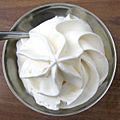Colloid facts for kids
A colloid is a special kind of mixture where tiny particles of one substance are spread out evenly through another substance. These tiny particles are bigger than the particles in a solution (like sugar dissolved in water), but they are too small to be seen easily with just your eyes, and they don't settle to the bottom over time like the particles in a suspension (like sand in water). Think of it as being in between a solution and a suspension!
Contents
What is a Colloid?
Imagine you have a glass of water. If you add sugar and stir, the sugar seems to disappear, right? It dissolves completely, and you can't see the sugar particles anymore. That's a solution. The sugar particles are very, very tiny.
Now, imagine you add sand to water. If you stir it up, you can see the sand particles floating around for a bit, but if you let it sit, the sand will sink to the bottom. That's a suspension. The sand particles are big enough to see and heavy enough to settle.
A colloid is different from both of these. In a colloid, you have tiny particles of one substance spread throughout another substance. These particles are bigger than the dissolved particles in a solution, but they are smaller than the particles in a suspension. Because they are just the right size, they stay mixed and don't settle out.
The substance that is spread out is called the dispersed phase, and the substance it's spread through is called the dispersion medium. These can be solids, liquids, or gases!
Preparation
There are two principal ways to prepare colloids:
- Dispersion of large particles or droplets to the colloidal dimensions by milling, spraying, or application of shear (e.g., shaking, mixing, or high shear mixing).
- Condensation of small dissolved molecules into larger colloidal particles by precipitation, condensation, or redox reactions. Such processes are used in the preparation of colloidal silica or gold.
Types
Colloids can be made by mixing different states of matter (solid, liquid, or gas). The type of colloid depends on what the dispersed phase is and what the dispersion medium is. Here are some common types:
- Sol: This is a colloid where tiny solid particles are spread out in a liquid. Examples include paint (solid pigment in liquid) and some inks. Even blood is considered a sol, with blood cells and proteins dispersed in plasma!
- Emulsion: This is a colloid where tiny liquid droplets are spread out in another liquid that they wouldn't normally mix with. Milk is a great example – it's tiny fat droplets spread out in water. Mayonnaise is another emulsion, made of oil and vinegar (or lemon juice) with egg yolk helping to keep them mixed.
- Foam: This is a colloid where gas bubbles are spread out in a liquid or a solid. Whipped cream is a liquid foam (gas in liquid), and something like styrofoam is a solid foam (gas in solid).
- Aerosol: This is a colloid where tiny solid particles or liquid droplets are spread out in a gas. Fog and mist are liquid aerosols (liquid in gas). Smoke and dust in the air are solid aerosols (solid in gas).
- Gel: This is a colloid where a liquid is spread out within a solid network, making a jelly-like substance. Jelly and gelatin are examples of gels.
| Medium/phase | Dispersed phase | |||
|---|---|---|---|---|
| Gas | Liquid | Solid | ||
| Dispersion medium |
Gas | No such colloids are known Helium and Xenon are known to be immiscible under certain conditions. |
Liquid aerosol Examples: fog, clouds, mist, hair sprays |
Solid aerosol Examples: smoke, ice cloud, atmospheric particulate matter |
| Liquid | Foam Example: whipped cream, shaving cream |
Emulsion Examples: milk, mayonnaise, hand cream; latex |
Sol Examples: pigmented ink, blood |
|
| Solid | Solid foam Examples: aerogel, styrofoam, pumice |
Gel Examples: agar, gelatin, jelly |
Solid sol Example: cranberry glass |
|
History
People have been using and making colloids for a very long time, even before they knew the science behind them. Ancient people used things like milk, paint, and ink, which are all colloids.
The scientific study of colloids really started to develop in the 1800s. A Scottish scientist named Thomas Graham is often called the "father of colloid chemistry." In the 1860s, he studied how different substances moved through membranes. He noticed that some substances, like sugar or salt, passed through easily (these were later called crystalloids, which form true solutions). Other substances, like glue or gelatin, passed through very slowly or not at all. Because these substances reminded him of glue (which is "kolla" in Greek), he called them colloids in 1861. He realized that the difference was not about the type of substance itself, but about the size of the particles it formed when mixed with a liquid.
Another famous scientist, Michael Faraday, also did important work with colloids, particularly with gold colloids, in the mid-1800s. He made beautiful ruby-red solutions by making very tiny gold particles that stayed suspended in water.
Over time, scientists learned more and more about the properties of colloids, like the Tyndall effect and Brownian motion, which helped them understand why these mixtures behave the way they do. Today, colloid science is a big and important field!
Colloids in Your Everyday Life
You might be surprised how many things you use or see every day are colloids!
- Food: Milk, cream, butter, mayonnaise, jelly, whipped cream, cheese, and even some types of candy are colloids. The textures and appearances of these foods are often due to their colloidal nature.
- In Your Home: Paint, ink, glue, toothpaste, shampoo, liquid hand soap, and many cleaning products are colloids.
- In Nature: Fog, clouds, mist, smoke, and even blood are natural colloids. The blue color of the sky is partly due to the scattering of sunlight by tiny particles (aerosols) in the atmosphere, which is a colloidal phenomenon. Soil can also contain colloidal particles.
- Materials: Some materials like rubber, plastics, and certain types of glass (like ruby glass, which contains tiny gold particles) are colloids.
- Medicine: Some medicines are prepared as colloidal dispersions to help the body absorb them better.
Colloids are important in many industries, including food production, manufacturing, medicine, and even environmental science (like studying air pollution or water quality). Scientists and engineers work with colloids to create new materials and improve existing products.
Interesting facts about colloids
- The particles in a colloid are super small, usually between 1 nanometer and 1000 nanometers in size. To give you an idea of how small that is, a nanometer is one billionth of a meter!
- One cool thing about colloids is something called the Tyndall effect. This happens when you shine a beam of light through a colloid. The tiny particles in the colloid scatter the light in all directions, making the beam of light visible.
- Another interesting property of colloidal particles is that they are constantly moving in a zig-zag, random way. This is called Brownian motion, named after the scientist Robert Brown who first observed it while looking at pollen grains in water. This constant bumping around by the molecules of the dispersion medium helps keep the colloidal particles from settling.
- You can't usually separate the parts of a colloid by just filtering it with regular filter paper, like you can with a suspension. The colloidal particles are too small to be caught by the filter paper.
Images for kids
-
SEM image of a colloid.
-
Tyndall effect in an opalite: it scatters blue light making it appear blue from the side, but orange light shines through; opal is a gel in which water is dispersed in silica crystals
See also
 In Spanish: Coloide para niños
In Spanish: Coloide para niños











